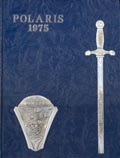Description: The patch is an isosceles triangle of sky blue bordered in blue. A black and white Polaris star dominates it. Behind the star is a jet plane taking off into the blue skies. The airfield below is a checkered design with black and silver squares in the foreground, blue and black squares in the second row, gold and black squares in the third row, and red and black going into the distance. “12th Squadron” is printed in blue across the bottom of the triangle on a silver band.
Significance: The Polaris provides a never failing light to guide cadets on their flight through life. It also serves as a reminder that there is no goal in life too high to attain. The aircraft in the background signifies the profession cadets have chosen as their life’s work. Its position in flight symbolizes the beginning of cadets’ mission of defense and protection of their country. The four colors represent the four class colors. The checkerboard pattern is the traditional symbol of the original squadron sponsors, the 401st Tactical fighter Wing.
History: This is the original patch and was designed by William R. Povilus, Class of 1963.
Nickname: "Dirty Dozen"
 1965 –
1965 –













